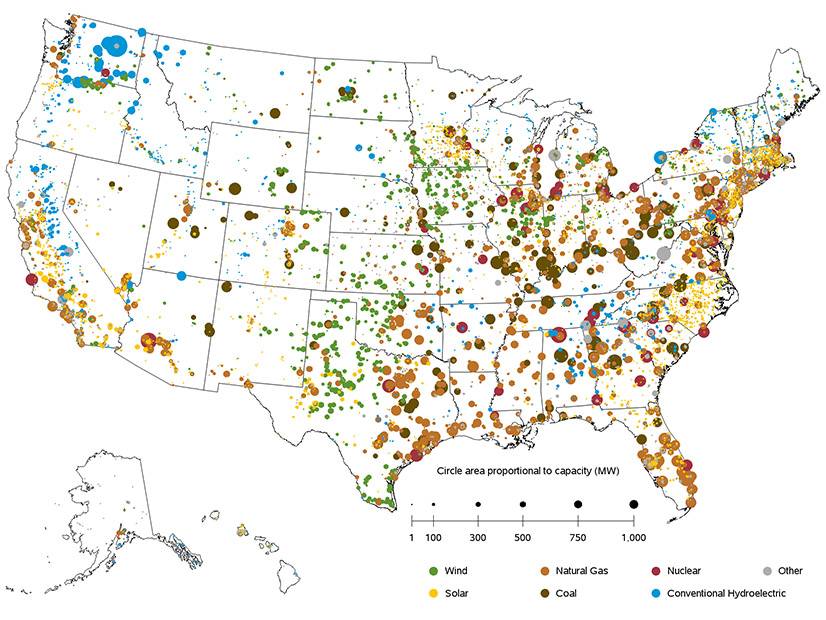
The U.S. government, which buys more than 9 TWh of electricity per year from competitive retail markets, issued a request for information Thursday in its first step toward ensuring all that power will be carbon-free by 2030.
President Joe Biden set that goal in December, with his executive order on federal sustainability and energy procurement (EO 14057). The order calls for each federal agency to “increase its percentage use of carbon pollution-free electricity, so that it constitutes 100% of facility electrical energy use on an annual basis, and seek to match use on an hourly basis to achieve 50 percent 24/7 carbon pollution-free electricity, by fiscal year 2030.” (See Biden Calls for Federal Procurement of 100% Clean Energy by 2030.)
The RFI is a joint effort by the General Services Administration and the Department of Defense and particularly seeks input from power providers and other stakeholders in the PJM, ERCOT, ISO-NE, MISO and NYISO markets. The deadline for submitting comments is March 7.
Annual targets for carbon-free electricity (CFE) procurement across these markets include:
- A minimum of 100-250 GWh for each of the five RTOs and ISOs or
- 500-1,000 GWh for ERCOT and PJM or
- more than 1,000 GWh for PJM only.
In a press release announcing the RFI, Federal Chief Sustainability Officer Andrew Mayock said that leveraging that kind of “scale and procurement power” will allow the Biden administration to “accelerate the development of America’s emerging clean tech industries,” create jobs and help American businesses compete in global markets.
The RFI guidelines use a broad definition of carbon-free electricity, ranging from solar, wind and geothermal to nuclear, “renewably sourced hydrogen” and fossil fuels with carbon capture and storage “that meets EPA requirements.”
But the guidelines clearly lean toward renewables and set high standards for potential projects. For example, the government would prefer carbon-free procurements that provide “new or previously underutilized generation sources” and that are located within a grid operator’s service territory. The expectation is that these procurements could spur 10 GW of new clean energy development across the country by 2030, the RFI says.
Further, to avoid any appearance of greenwashing, the RFI also requires new renewable projects to come with bundled renewable energy credits (RECs), indicating that the government wants to ensure the RECS are retired, rather than being sold to offset a utility’s or corporation’s carbon emissions.
The government expects the CFE procurements “to be integrated into existing electricity procurements in a phased approach over several years, through both the transition of existing retail supply contracts, and where appropriate, new power generation procurements,” the RFI says.
The GSA and DOD want to start phasing in contracts for clean power this year, with deliveries beginning in 2023.
Noting that the DOD is one of the largest electricity users in the U.S., Deputy Secretary of Defense Kathleen Hicks said the RFI will signal to the market the government’s intent to play a leading role in the energy transition. “It’s not just critical to addressing the threat of climate change, but also to our national security as we work to secure U.S. competitiveness in rapidly shifting global energy markets,” Hicks said.
24/7 Clean Power
The big question now is whether and how individual RTOs and ISOs will be able to meet the government’s goals. While ambitious, figures on current renewable generation and projected growth suggest the CFE procurement targets are achievable.
 PJM generation by fuel source | Monitoring Analytics
PJM generation by fuel source | Monitoring AnalyticsAccording to figures from FERC, renewable energy represented 85.9% of new generation in the U.S. in the first 10 months of 2021, and the National Renewable Energy Laboratory has reported that interconnection queues across the country are backed up with 750 GW of wind, solar and storage projects.
Coming up with 250 GWh may not be a big stretch for ISO-NE, which at present supplies about 500 GWh to the federal government and had almost 19,500 GWh of renewables, including hydro, in its generation mix in 2021, 19% of its generation.
Similarly, at 7,500 GWH per year, PJM is the government’s top retail market power provider and, as of 2020, was producing more than 30,000 GWh from wind and solar. PJM is planning to change its rules for connecting new wind and solar projects to the grid so that shovel-ready projects will go to the head of the queue. The proposed changes would also streamline approval for projects that do not require a facilities study or any network upgrades. (See PJM PC/TEAC Briefs: Jan. 11, 2022.)
The bigger challenge may be meeting the executive order’s requirement that 50% of the power procured be able to match demand hour for hour around the clock. For example, the RFI guidelines do not include energy storage as part of annual calculations of 100% carbon-free energy but can be included as part of a portfolio of resources to meet the 24/7 power matching requirements.


